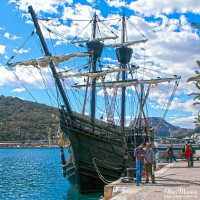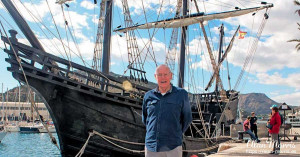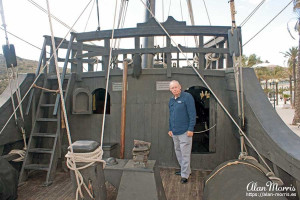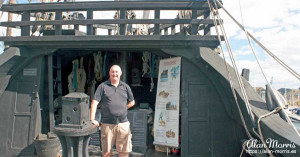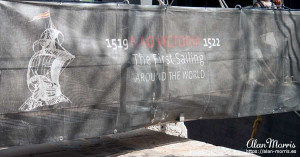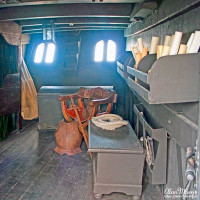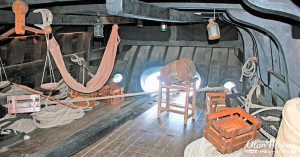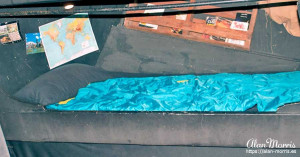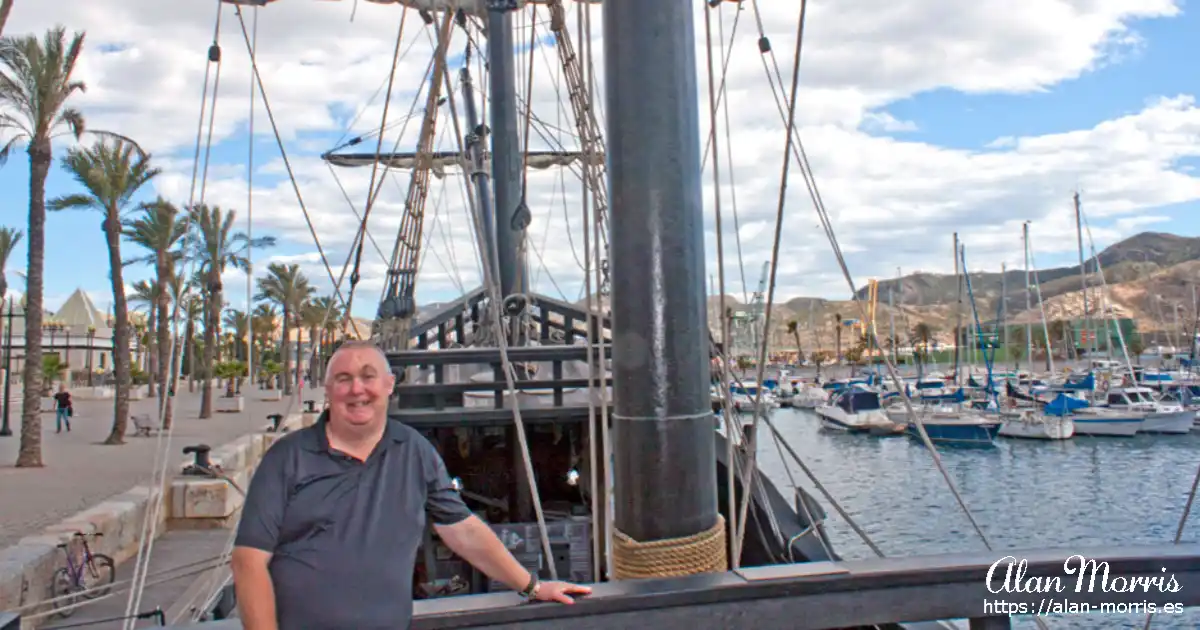The Nao Victoria was the first ship to sail around the world. My friend Adrian and I went to see a full-size replica of it moored in Cartagena.
My friend Adrian Maplebeck had seen that the Nao Victoria was in Cartagena harbour, so we decided to go and take a look at it. Adrian drove us down to Cartagena, and we spent a morning looking around the ship.
The original Nao Victoria.
The original Victoria was part of a Spanish expedition commanded by the Portuguese explorer Ferdinand Magellan, who was killed in the Philippines on the voyage. After his death, the expedition was led by Juan Sebastián Elcano. The expedition began with five ships, but the Victoria was the only ship to complete the voyage. The Victoria was built at a shipyard in Gipuzkoa, with the Basques being reputed shipbuilders at the time, along with the four other ships, The Trinidad, The San Antonio, The Concepcion and The Santiago. It was given to Magellan by King Charles I of Spain. The Victoria was an 85-tonne ship with a crew of 42.
The long circumnavigation began in Seville, Spain, in 1519 and returned in early September 1522 after travelling 68,000 kilometres. 35,000 kilometres of which were largely unknown to the crew. On December 21, 1521, Victoria sailed on alone because the other ships had left the convoy due to lack of food and water rations or had been captured or sank. The ship was in terrible shape, with her sails torn and only kept afloat by continuously pumping water. Victoria managed to pull through and return to Spain with a shipload of costly spices.
Expedition Crews.
The voyage started with a crew of about 265 men aboard the five ships. Of all these, only 18 men returned alive on the Victoria. Many of the men died of malnutrition.
At the beginning of the voyage, Luis De Mendoza was Captain of the Victoria. On April 2, 1520, after establishing a settlement they called Puerto San Julian in Patagonia, a fierce mutiny involving three captains broke out, but it was ultimately quelled.
Antonio Pigafetta's and other reports state that Luis de Mendoza and Gaspar Quesada, Captain of the Concepcion, were executed and their remains hung on gallows on the shore. Juan de Cartagena, Captain of the San Antonio, was marooned on the coast. Duarte Barbosa, a Portuguese man who had sided with Magellan in facing the mutiny, then became the captain of The Victoria. According to Pigafetta, after Magellan's death on April 27, 1521, at the Battle of Mactan, remnants of the fleet tried to retrieve Magellan's body without success. After that, Duarte Barbosa and João Serrão were elected leaders of the expedition.
On May 1, 1521, Rajah Humabon of Cebu, of the Philippines, invited them to a banquet ashore to receive a gift for the king of Spain. There, most were killed or poisoned, including Duarte Barbosa João Serrão. Pilot João Carvalho, who had survived the trap, then became the captain of The Victoria. In August, near Borneo, he was deposed, and Juan Sebastián Elcano became Captain for the remainder of the expedition.
Returning Crew.
Out of an entire expedition of 265 people, only 18 returned to Seville with the expedition (many others deserted), which by the end was only made up of the crew of the Victoria.
The crew that returned consisted of the following;
| Name. | Rating. |
| Juan Sebastián Elcano. | Master |
| Francisco Albo. | Pilot |
| Miguel de Rodas | Pilot |
| Juan de Acurio | Pilot |
| Antonio Lombardo Pigafetta | Supernumerary |
| Martín de Judicibus | Mariner |
| Hernándo de Bustamante | Mariner |
| Nicholas the Greek | Mariner |
| Miguel Sánchez | Mariner |
| Antonio Hernández Colmenero | Mariner |
| Francisco Rodrigues | Mariner |
| Juan Rodríguez | Mariner |
| Diego Carmena | Mariner |
| Hans of Aachen | Gunner |
| Juan de Arratia | Able Seaman |
| Vasco Gómez Gallego | Able Seaman |
| Juan de Santandrés | Apprentice Seaman |
| Juan de Zubileta | Page |
Of all these survivors, Antonio Pigafetta was the most significant because his journals supplied most of the information about the first expedition around the world.
Victoria was later repaired, bought by a merchant shipper and sailed for almost another fifty years before being lost with all hands on a trip from the Antilles to Seville in about 1570.
Replica of The Nao Victoria.
The replica of Victoria was built in Spain in 1991. The new Victoria's designer, Ignacio Fernandez Vial, carried out extensive research on the original ship using documentary evidence, journals, chronicles, nautical treaties from the 16th century, and iconography from the era. This allowed him to accurately reproduce the original ship's dimensions, spars, sails, and equipment.
To commemorate the first sailing around the world, the replica of the Nao Victoria started another round-the-world trip starting, as the original had, from Seville in Spain. Around 26,894 miles were covered during the trip, visiting 17 countries between 2004 and 2006.
Summary.
I enjoyed my trip to see the Nao Victoria and still find it hard to believe that this ship sailed worldwide. I have seen bigger ships used as climbing frames to entertain kids in a McDonald's restaurant. Even in the still water of Cartagena harbour, you could feel the ship rocking on the water. Out at sea, this must have been terrible, in a storm, horrendous. It would be safe to assume that the crew members were of a more petite build than the average person today, as getting around the ship would be hard for anyone of an average build now. For my next trip out on the high sea, I will stick to one of today's ocean-going liners with a comfy bed, an ensuite bathroom, a five-star restaurant, bars and a full live entertainment calendar.
Nao Victoria Photos.
These photos were all taken when I saw a full-size replica of the Nao Victoria in Cartagena when I went on a trip to see it with my friend Adrian in 2016.
Click on any image to see a larger version of the image with a description. Use the navigation below the thumbnail images to see the previous set of images, the next set of images, or the previous or following photo albums.
